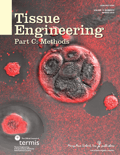
Tissue Engineering Part C-Methods
Scope & Guideline
Showcasing Methodologies that Redefine Tissue Engineering
Introduction
Aims and Scopes
- Tissue Engineering Methodologies:
The journal covers a broad range of methodologies for tissue engineering, including scaffold development, cell culture techniques, and bioreactor systems, focusing on how these techniques can be optimized for better tissue regeneration. - Biomaterials Development:
Research on various biomaterials, including natural and synthetic polymers, hydrogels, and bioactive glass, is a significant focus. The journal explores how these materials can enhance cell adhesion, proliferation, and differentiation. - Stem Cell Applications:
The use of stem cells in tissue engineering is a prominent theme, with studies investigating their differentiation pathways and the impact of various scaffolds and growth factors on their regenerative potential. - In Vitro and In Vivo Models:
The journal emphasizes the development and validation of in vitro and in vivo models for studying tissue engineering applications, critical for assessing the efficacy and safety of engineered tissues. - Immunomodulation in Tissue Engineering:
Research on how the immune response affects tissue regeneration is increasingly relevant, with studies focusing on techniques to modulate immune responses to improve graft acceptance and functionality.
Trending and Emerging
- 3D Bioprinting Techniques:
There is a growing trend towards the use of 3D bioprinting technologies for creating complex tissue structures, allowing for precise control over scaffold architecture and cellular organization. - Extracellular Vesicles and Cell Secretome Studies:
Research focusing on the role of extracellular vesicles and the secretome from various cell types is gaining momentum, highlighting their potential in regenerative therapies and as biomarkers. - Personalized Medicine Approaches:
The journal is increasingly publishing studies that emphasize personalized medicine, particularly in the context of using patient-derived cells and tailored scaffolds for tissue regeneration. - Integration of AI and Machine Learning:
The incorporation of artificial intelligence and machine learning techniques into tissue engineering research is on the rise, particularly in optimizing scaffold designs and predicting cell behavior. - Immunomodulatory Biomaterials:
The development and study of biomaterials that can actively modulate the immune response to enhance tissue integration and regeneration are emerging as a significant area of interest.
Declining or Waning
- Traditional 2D Cell Culture Models:
There has been a noticeable decline in the publication of studies utilizing traditional 2D cell culture models, as researchers increasingly adopt more advanced 3D culture techniques that better mimic the in vivo environment. - Basic Biomaterial Characterization:
Research solely focused on the basic characterization of biomaterials without application to specific tissue engineering challenges is becoming less common, as the field moves towards more applied research that addresses clinical needs. - Animal Models with Limited Clinical Relevance:
Studies involving animal models that do not translate well into human applications are decreasing, with a shift towards models that better represent human physiology and disease states. - Non-Functionalized Biomaterials:
The exploration of non-functionalized biomaterials is diminishing as the focus shifts towards biofunctionalization strategies that enhance interaction with biological systems and improve regenerative outcomes.
Similar Journals

Regenerative Biomaterials
Advancing the Future of RegenerationRegenerative Biomaterials, published by Oxford University Press, serves as a premier platform for the dissemination of innovative research in the rapidly evolving field of biomaterials. Since its inception in 2014, this esteemed open-access journal has fostered a collaborative and diverse scientific community, providing free access to impactful articles that enhance our understanding of regenerative medicine and tissue engineering. With a commendable impact factor and ranking within the top quartiles of both Biomedical Engineering and Materials Science, it is recognized for its rigorous peer-review process and high-quality publications. The journal aims to bridge the gap between fundamental research and applied sciences, promoting advanced studies that contribute to clinical applications and regeneration strategies. Researchers, practitioners, and students alike are encouraged to engage with the journal’s content to foster interdisciplinary collaboration and drive future innovations in the biomaterials domain.
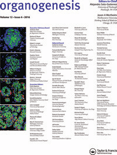
Organogenesis
Exploring the Pathways of Regeneration and Growth.Organogenesis is a leading journal published by Taylor & Francis Inc, dedicated to advancing the field of developmental biology and regenerative medicine. With an ISSN of 1547-6278 and E-ISSN 1555-8592, this journal spans an extensive research scope that includes embryology, transplantation, and biomedical engineering, distinguishing itself as a crucial platform for researchers and practitioners alike. Its impact is reflected in its performance across various categories in 2023, earning Q3 rankings in Biomedical Engineering and Embryology, Q4 in Developmental Biology, and Q2 in Transplantation, showcasing its reputable standing among peer journals. Moreover, with Scopus rankings indicating strong positioning in the fields of medicine and biochemistry, Organogenesis is essential for those looking to publish or stay updated on pioneering research. The journal facilitates rigorous peer-review and offers a forum for disseminating innovative findings, making it an invaluable resource for academics, professionals, and students committed to understanding the complexities of organism development.
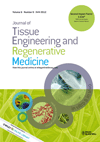
Journal of Tissue Engineering and Regenerative Medicine
Cultivating knowledge at the intersection of engineering and biology.Journal of Tissue Engineering and Regenerative Medicine, published by WILEY, stands as a pivotal platform in the fields of biomaterials, biomedical engineering, and regenerative medicine. With an ISSN of 1932-6254 and an E-ISSN of 1932-7005, this journal, based in the United Kingdom, has consistently delivered high-quality research since its inception in 2006, converging critical insights through 2024. With an impressive citation profile reflected in its Scopus rankings—specifically a rank of #58 in Medicine and #75 in Biomedical Engineering—the journal is acknowledged for its substantial impact, as demonstrated by its competitive quartile standings in 2023. Notably, it maintains a Q3 ranking in Biomaterials and Q2 in both Biomedical Engineering and Medicine (miscellaneous), showcasing its influence and relevance in the rapidly evolving interplay between engineering and medicine. The journal serves as a vital resource for researchers and practitioners aiming to stay abreast of innovations and breakthroughs in regenerative therapies, tissue scaffolds, and biomaterials. While not an open-access publication, it fosters academic dialogue and knowledge dissemination that is crucial for advancing the field.

Tissue Engineering and Regenerative Medicine
Elevating the Science of Tissue Engineering and RegenerationTissue Engineering and Regenerative Medicine, published by the Korean Tissue Engineering Regenerative Medicine Society, is a distinguished journal focusing on the interdisciplinary fields of tissue engineering, regenerative medicine, and related biomedical innovations. With an ISSN of 1738-2696 and an E-ISSN of 2212-5469, this journal disseminates cutting-edge research and advancements pivotal to developing therapeutic strategies that improve tissue function and repair. As a testament to its scholarly impact, it holds a Q2 ranking in both Biomedical Engineering and Medicine (miscellaneous) categories, reflecting its influence and relevance within the scientific community, particularly with a Scopus rank placing it in the 82nd percentile among similar journals. Although the journal does not offer open access, it provides vital insights and knowledge to researchers, professionals, and students involved in the quest for innovative solutions in medical science and engineering. With its convergence years extending from 2008 to 2024, the journal continues to be an essential platform for the dissemination of high-quality research that drives the field forward.
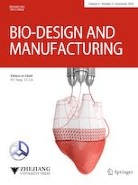
Bio-Design and Manufacturing
Empowering Innovation at the Intersection of Biology and ManufacturingBio-Design and Manufacturing, published by SPRINGER HEIDELBERG, is a pioneering journal that stands at the forefront of innovation in the fields of Biomedical Engineering, Biotechnology, Industrial and Manufacturing Engineering, and Materials Science. With its ISSN 2096-5524 and E-ISSN 2522-8552, this journal has established itself as a leading platform for disseminating cutting-edge research and advancements that merge biological principles with manufacturing processes, emphasizing sustainable and efficient practices. It has garnered recognition in the 2023 category quartiles, boasting a Q1 rank in all its relevant fields, which underscores its significance and impact—evident from its prime Scopus rankings that place it within the top percentiles of numerous engineering and materials science disciplines. Researchers, professionals, and students alike benefit from the wealth of knowledge presented in this journal, making it an essential resource for those seeking to enhance their understanding of bio-design applications and innovation in manufacturing processes.
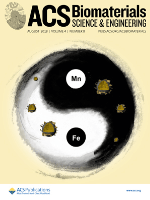
ACS Biomaterials Science & Engineering
Elevating Biomaterials Science to New HeightsACS Biomaterials Science & Engineering, published by the American Chemical Society, serves as a premier platform for the latest advancements and research in the fields of biomaterials and biomedical engineering. With an impressive impact factor and a strong reputation reflected in its ranking—Q2 in Biomaterials and Q1 in Biomedical Engineering—the journal attracts a diverse and engaged readership. Since its inception in 2015, it has aimed to foster innovation by publishing high-quality research articles, reviews, and perspectives on the synthesis, characterization, and application of biomaterials. Researchers and professionals benefit from the journal's rigorous peer-review process and its focus on translational science, making it essential for those looking to stay at the forefront of biomaterials research. Located in Washington, DC, USA, the journal plays a pivotal role in connecting academic and industrial sectors, ultimately driving advancements that impact biomedicine and related fields.
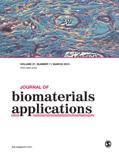
JOURNAL OF BIOMATERIALS APPLICATIONS
Fostering innovation in biomaterials and tissue engineering.JOURNAL OF BIOMATERIALS APPLICATIONS, published by SAGE PUBLICATIONS LTD, serves as a pivotal platform for the dissemination of cutting-edge research in the field of biomaterials and biomedical engineering. With an ISSN of 0885-3282 and an E-ISSN of 1530-8022, this journal has been a respected venue for scholarly communication since its inception in 1986. Aiming to provide comprehensive insights into the applications of biomaterials, this journal publishes high-quality articles that explore innovative materials and methodologies, thereby fostering advancements in medical technology and tissue engineering. The journal consistently ranks in the third quartile (Q3) for both Biomaterials and Biomedical Engineering categories, strengthening its position among the noteworthy academic resources available today. With a dedicated readership comprising researchers, industry professionals, and students, JOURNAL OF BIOMATERIALS APPLICATIONS plays a vital role in supporting knowledge exchange and scientific progress within these dynamic fields.
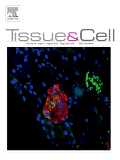
TISSUE & CELL
Connecting Research to Real-World ImpactTISSUE & CELL is a prominent academic journal, published by CHURCHILL LIVINGSTONE, that has been at the forefront of research in the fields of cell biology, developmental biology, and miscellaneous areas of medicine since its inception in 1969. With a strong focus on high-quality research, TISSUE & CELL has established itself within the academic community, holding a Q3 ranking in both Cell Biology and Developmental Biology, and a Q2 ranking in Medicine as of 2023. The journal aims to disseminate significant findings that contribute to the understanding of tissue structure and function, helping to bridge the gap between basic biological research and clinical applications. While it operates on a subscription basis and does not currently offer Open Access options, the journal remains a vital resource for researchers, professionals, and students interested in cutting-edge developments in the biological sciences. The journal's address is located in the scenic city of Edinburgh, further establishing its academic heritage in the United Kingdom.

Cell Regeneration
Exploring the Future of Regenerative BiologyCell Regeneration, published by SPRINGERNATURE, stands at the forefront of biological research, focusing on the dynamic field of cellular development and regenerative biology. Since its establishment in 2012, this journal has embraced an Open Access model, facilitating widespread dissemination of key findings and fostering collaboration among researchers in the Netherlands and beyond. With an impact factor underscoring its significance, Cell Regeneration is positioned in the Q2 category in both Cell Biology and Developmental Biology as of 2023, ranked #32 out of 82 and #170 out of 285 in relevant Scopus peer fields. The journal encompasses a broad spectrum of research that advances our understanding of cellular processes, offering vital insights into regenerative mechanisms and their applications in therapies. This robust platform not only serves as a valuable resource for researchers, professionals, and students but also encourages scholarly dialogue and innovation in the fast-evolving landscape of cell biology.
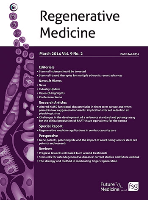
Regenerative Medicine
Pioneering Discoveries in Biomedical RegenerationRegenerative Medicine, published by Taylor & Francis Ltd, is a pivotal journal within the field of biomedical research, focusing on the innovative advances in regenerative and restored functions in human health. With an ISSN of 1746-0751 and an E-ISSN of 1746-076X, this esteemed journal boasts a commendable impact factor within its categories, notably holding the Q2 status in Embryology and Q3 in Biomedical Engineering as of 2023. Covering a broad spectrum of topics from stem cell research to tissue engineering, it serves as a crucial platform for interdisciplinary collaboration among researchers, professionals, and students dedicated to the regeneration of tissues and organs. Given its comprehensive scope from 2006 to 2024, the journal continues to attract high-quality manuscripts that advance the frontiers of knowledge in regenerative medicine. Researchers and practitioners alike are encouraged to engage with the latest findings and methodologies disseminated in this vital publication.